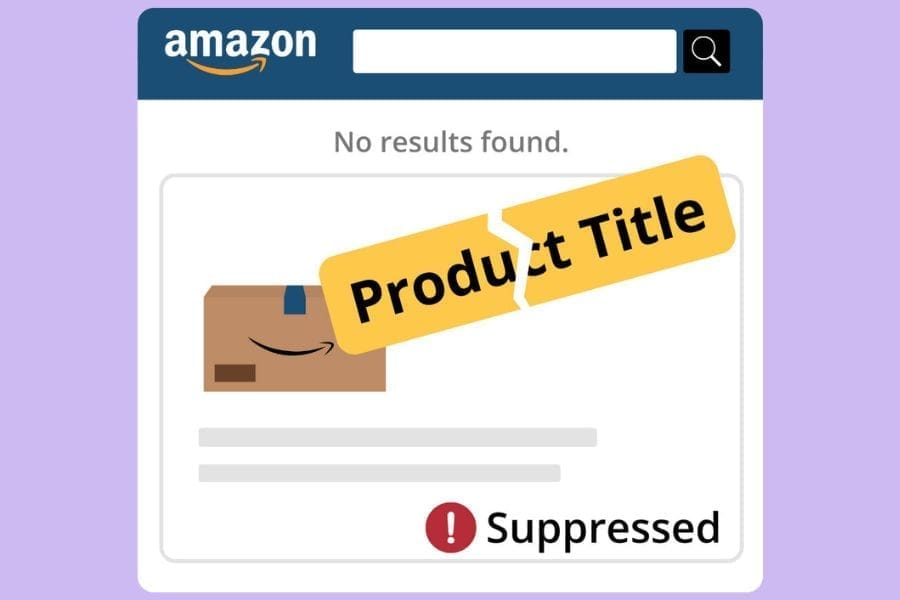intelliRANK Blog
How to Write Amazon Product Titles That Actually Sell
Get the FREE 4-step Strategy Plan eBook
that will help you Increase your Amazon Sales immediately...
Your product title is one of the most important pieces you have, when it comes to selling on Amazon. It’s the first thing shoppers see in search results, the first text their eyes scan on a product page, and often the deciding factor in whether they click or scroll past.
A strong title can mean the difference between being buried in the crowd or standing out and driving sales.
But… Amazon has strict rules for how titles should be structured, and ignoring those can result in suppressed listings or worse.

So, how do you create a product title that’s both compliant with Amazon’s requirements and irresistible to buyers?
That’s what this guide is all about.
We’ll break down how Amazon’s algorithm looks at titles, the rules you need to follow, and the strategies you can use to make your titles not just visible. But compelling enough to actually sell.
Why Your Product Title Matters More Than You Think
On Amazon, your title plays 2 critical roles:
1. Ranking Power
Amazon’s algorithm relies heavily on the keywords in your title to understand what your product is and match it to relevant search queries.
The right keywords in the right order can dramatically improve your chances of appearing on page one.
2. Conversion Power
Shoppers don’t read titles the way we imagine. They skim. They pick out certain words, benefits, or numbers. If your title doesn’t immediately confirm that your product solves their problem or matches their search intent, they’ll click away.
In other words, your title has to speak two languages at once: the algorithm’s language (keywords, structure, clarity) and the shopper’s language (benefits, appeal, trust).
Understanding Amazon’s Product Title Requirements
Before you can get to the writing part, you have to understand the rules. Amazon has specific style guides that vary slightly by category, but here are the general title requirements you should know:
Length: Titles should typically be under 200 characters (many categories cap at 150).
Capitalization: Use title case (capitalize the first letter of each word) and avoid ALL CAPS.
Prohibited content: No promotional phrases like “Best Seller,” “Free Shipping,” or “100% Guaranteed.”
Special characters: Avoid symbols like “!” or “$” unless they are part of the product’s official name.
Relevance: Only include information directly related to the product (no competitor names, no unrelated keywords).
Key elements: Brand name, product type, key features (size, color, material), quantity/pack.
Following these rules is non-negotiable. A title that violates guidelines risks suppression, which means your product disappears from search until fixed.
The Balancing Act: Compliance vs. Appeal
Here’s the real challenge: titles that are strictly compliant can sometimes read stiff, robotic, or overloaded with specs.
The key is to blend compliance with creativity. Your title should include the right keywords and product details for Amazon’s algorithm while still sounding human and appealing to real people.
The Anatomy of a High-Performing Amazon Title
Let’s break down the components of an effective title and how to optimise each:
Brand Name: Amazon recommends starting with your brand. This builds recognition and protects against competitors bidding on your name.
Main Product Keyword: Include the primary keyword customers use to search for your product. This ensures relevance and ranking.
Defining Attributes: Size, color, material, flavor, or quantity — whatever shoppers use to filter their choices should go here.
Key Benefit or Feature: Here’s where you differentiate. What makes your product unique or appealing? (e.g., “Leakproof,” “Eco-Friendly,” “Slim Fit”).
Secondary Keyword (Optional): If space allows, include a secondary keyword that captures additional traffic.
How to Research Keywords for Titles
The backbone of a strong Amazon title is keyword research. Without the right keywords, your title won’t rank, no matter how appealing it sounds.

Steps to find the right keywords:
Start with Amazon’s search bar: Type your product type and note the autocomplete suggestions. These are real search queries.
Use Amazon Brand Analytics: If you’re Brand Registered, leverage this tool to see what shoppers are searching.
Look at Competitors: Analyze the top-ranking listings in your category. What terms do they include?
Focus on Intent: Choose keywords that signal buying intent, not just browsing.
4 Best Practices for Writing Amazon Titles That Sell
To make it work for both Amazon’s algorithm and real buyers, it’s essential to follow a few proven best practices. Each one may seem small on its own, but together they create a title that’s compliant, keyword-rich, and compelling enough to earn the click.
1. Front-Load Important Keywords
Doing so improves both click-through rates and keyword ranking, since Amazon gives more weight to words at the front of a title. For example, a phrase like “Stainless Steel Travel Mug” at the start is far stronger than burying those terms at the end.
2. Highlight Benefits, Not Just Specs
Specs are important, but they don’t always tell the full story.
A shopper may see “16oz Stainless Steel” and think it’s nice, but pairing that with a benefit makes the title far more persuasive.
Instead of just writing “16oz Stainless Steel Water Bottle,” you could write “Durable 16oz Stainless Steel Water Bottle – Keeps Drinks Hot for 12 Hours.” This format answers the unspoken shopper question: why should I care about this feature?
3. Keep It Readable
Keyword stuffing might seem like a shortcut to rank for more searches, but in reality, it hurts readability and can reduce trust.
A title that’s too cluttered not only looks unprofessional, but may also be flagged by Amazon for violating policy. Stick to a natural flow that combines keywords with clear descriptions. A clean, professional-looking title reassures buyers that the product — and the brand — is high-quality.
4. Match Shopper Psychology
Every customer approaches Amazon with a problem they want solved or a desire they want fulfilled. Your title should speak directly to that intent.
Ask yourself: What is the shopper really looking for when they type in this keyword? Then shape the title to provide the answer.
For example, if the keyword is “leakproof lunchbox,” make sure the word “leakproof” appears early in your title, reassuring shoppers right away that your product solves their exact need.
4 Common Mistakes to Avoid in Amazon Titles
Even experienced sellers make errors that reduce the effectiveness of their titles. Here are the pitfalls to watch out for:
❌ Keyword stuffing: Trying to cram every possible keyword into one title, which makes it unreadable and unappealing.

❌ Promotional language: Adding words like “Best,” “Cheapest,” or “#1” is against Amazon’s policy and risks suppression.
❌ Unnecessary detail: Overloading the title with specs or features that don’t add value, confusing rather than helping shoppers.
❌ Ignoring category rules: Each Amazon category has its own style guide, and failing to follow it can result in warnings or suppressed listings.
Beyond Titles: The Bigger Listing Strategy
While titles are critical, they don’t work in isolation. Your entire listing — from images to bullet points to backend keywords — should work together to create a consistent, persuasive experience.
Titles bring the click.
Images build desire.
Bullet points answer objections.
A+ Content seals the deal.
When all elements are aligned, your listing truly converts.
Conclusion
Writing Amazon product titles is both a science and an art.
The science lies in following Amazon’s rules and optimizing for keywords. The art lies in making those titles persuasive and human enough to win the click.
By blending compliance with creativity, you can craft titles that Amazon rewards with visibility and buyers reward with sales.
If you’re serious about scaling on Amazon and want expert help crafting product titles and listings that actually sell, our team at intelliRANK is here to help.
From in-depth keyword research to title optimization and complete product listing creation, we build every element of your listing with 3 goals in mind: higher visibility, stronger conversions, and long-term brand growth.
© Copyright 2025 - intelliRANK.info - All rights reserved. Terms of Service. Cookie Declaration.










